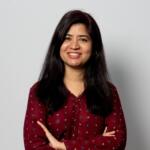Omnichannel Marketing: A Complete Guide for 2025 and Beyond

Reading Time: 24 minutes
Do you know 86% of shoppers regularly channel-hop across two channels? The offline shopping experience finds semblance in online browsing, where consumers are more than willing to hop across multiple channels to find what they’re looking for. Sometimes they end up making online purchases even as they stand in the queue at the physical store or use smartphones as shopping assistants at the stores. That’s why 87% of retailers recognize the omnichannel marketing strategy as crucial for their business. They realize that if they want to be at the top of their game, they need to offer a seamless user experience to customers across different touchpoints.
As a retailer, it’s time to acknowledge the significant impact of omnichannel marketing can have on your business and learn how to leverage it to create a unique experience for your customers and maximize your ROI.
Omnichannel marketing is about connecting with customers on their terms, empowering them to engage with your brand seamlessly across all channels.
Scott Brinker
We have compiled a comprehensive guide with tips, and omnichannel marketing strategies to help you build a successful omnichannel marketing campaign. Let’s get started.
What is Omnichannel Marketing and Why Do You Need It?
Harvard Business Review and a significant US retail company conducted a 14-month study to understand customers’ shopping behavior. They interviewed 46,000 shoppers and found the following:
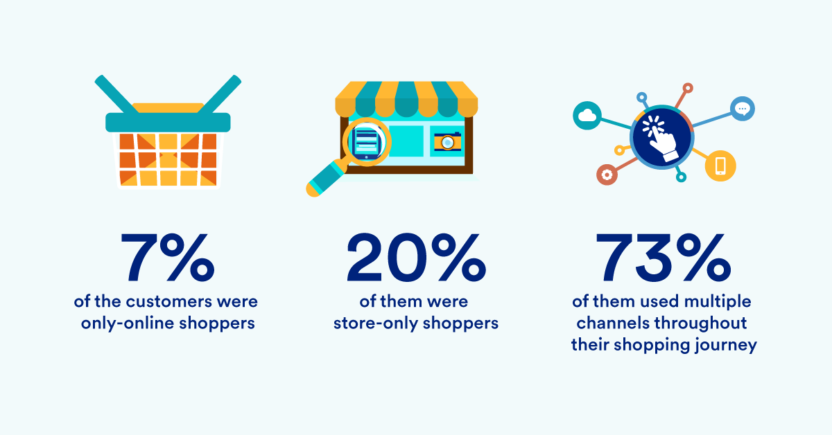
The study further revealed that the more channels the customers used, the more valuable they proved to be to the retailers. For example, the study found that customers who used more than 4+ channels spent 9% more in the store than the ones who used a single channel.
The writing was clear on the wall – omnichannel customer experience was no longer an option. The retailers had to rethink their customer journeys and find new ways to acquire, engage, and retain customers through positive experiences across multiple touchpoints.
Digital channels are a crucial component of these touchpoints. Incorporating these channels into their omnichannel marketing strategy is crucial for retailers. Such channels often lead to a positive encounter between the customer and retailers, allowing retailers to connect with their customers across various touchpoints while creating cohesive and personalized experiences. So, what digital channels should retailers be looking at?
| Social Media: Social media platforms, like Facebook, Instagram, or Twitter allow retailers to not only connect with their consumers and share products but also build a personalization strategy, run targeted ads, and engage in real-time conversations. |
| Email Marketing: Email marketing has been and remains a powerful tool for retailers. It enables personalized communication, product recommendations, and promotional offers, nurturing long-term customer relationships. |
| Mobile Apps: Mobile apps have come to become crucial for retailers in today’s times. They make for a seamless shopping experience. These apps facilitate personalized product browsing, in-app purchases, and loyalty rewards. |
| Website: A user-friendly, informative website is essential. It serves as a digital storefront where customers can explore products, access reviews, and make purchases. Websites also often serve as a congregation or a core point for all digital channels. |
| Push Notifications: These deliver time-sensitive alerts, promotions, and updates to mobile app customers. |
| SMS: Text messages provide quick updates, order confirmations, and personalized offers to customers’ mobile phones. |
| E-commerce Platforms: Retailers utilize online marketplaces like Amazon and eBay to expand their digital presence and reach a broader customer base. |
| In-App Messaging: In-app messaging enables retailers to engage users with targeted content and offers within mobile apps. |
| Chatbots: AI-powered chatbots offer real-time customer support and assistance, enhancing customer experiences. |
| Display Advertising: Retargeting and display ads on websites and social media help re-engage potential customers interested in products. |
With new marketing channels emerging, it’s time retailers shift their focus from traditional marketing to omnichannel marketing strategies.
What Omnichannel Marketing Means for Industries?
Omnichannel marketing means creating your brand’s presence across multiple online (website, app, social media, email, SMS, WhatsApp) and offline (retail store, events, call center) channels while ensuring a positive and seamless experience throughout the customer journey.
Omnichannel marketing presents itself in different ways for different industries.
| Retail: In retail, omnichannel marketing means providing a seamless shopping experience across physical stores, e-commerce platforms, mobile apps, and social media. It enables customers to browse, purchase, and receive products through multiple channels, fostering brand loyalty. |
| E-commerce: For online businesses, it entails integrating various touchpoints like websites, mobile apps, email, and social media. It optimizes the customer journey, enabling customers to shop conveniently and receive personalized recommendations. |
| Finance: Banks and financial institutions utilize omnichannel strategies to provide customers with consistent services across branches, mobile apps, websites, and customer support channels. |
| Fintech: In the fintech sector, omnichannel marketing helps create a cohesive user experience across web and mobile applications, making it easier for users to manage their finances and access services seamlessly. |
| Media and Entertainment: Omnichannel marketing allows media and entertainment companies to engage users across various platforms, from streaming apps to social media, ensuring that content is accessible and enjoyable wherever the audience is. |
| Health and Fitness: Omnichannel marketing in health and fitness involves providing fitness enthusiasts with a consistent experience, from booking classes online to accessing workout plans through mobile apps, making their fitness journey smooth and convenient. |
Let’s say one of your customers receives a mobile push notification about a limited-time offer on a mobile app. If they don’t engage with it, they may receive an email reminder with the same offer or a more personalized one. This coordinated approach across mobile and email maximizes the chances of conversion.
Omnichannel marketing leverages technology to create seamless and personalized experiences across customer touchpoints.
You will notice that technology plays a vital role in omnichannel marketing. It enables the integration of online and offline channels, allowing customers to switch between them effortlessly. It ensures consistency in messaging, pricing, and product availability across channels, enhancing the customer experience.
Advanced analytics and AI technologies analyze customer data, helping businesses understand customer behavior and preferences. This data informs omnichannel marketing strategies, enabling personalized product recommendations and targeted promotions.
Technology also improves supply chain visibility and agility, allowing retailers to meet customer demands promptly. Real-time analysis and automation streamline the movement of goods from suppliers to customers. Last, chatbots, social media integrations, and mobile apps enable real-time customer interactions. Technology facilitates instant responses to queries and fosters engagement, building stronger relationships.
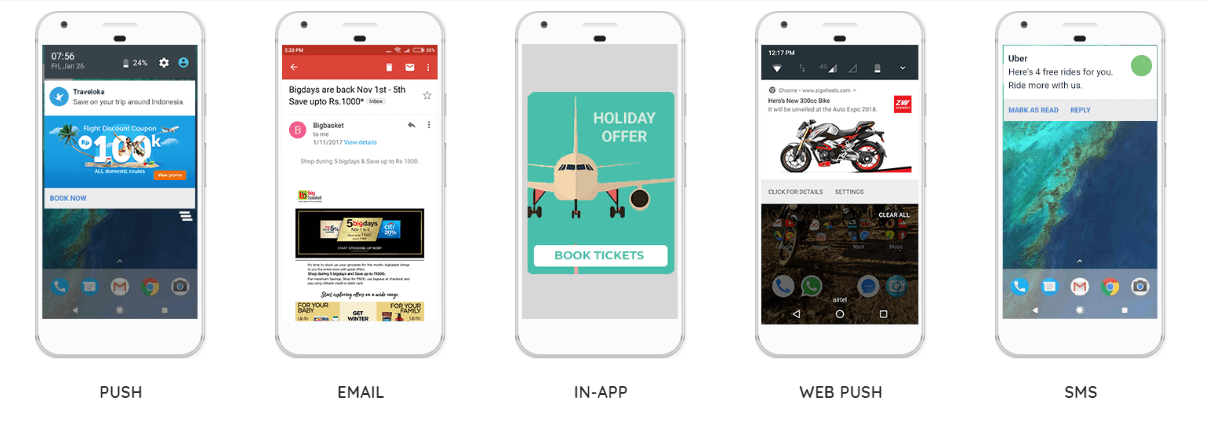
The word ‘positive’ and ‘seamless’ is crucial because 67% of the customers cite bad customer experience as the reason for churn. To acquire and retain customers, building an omnichannel marketing strategy that encapsulates all channels your customers prefer is crucial, and constantly improving it to reach your customers where they are and enhance customer experience is pivotal to achieving your business goals.
Why is Omnichannel Marketing Important?
Omnichannel marketing is essential because it helps you create a positive experience for the customer at every stage of their lifecycle, reduce churn, and drive + build a positive reputation for your brand. Let’s take an example. Imagine you are tired after a long day at work and want to grab a quick cup of coffee before heading home. We all know that long lines and long waits are a bank staple. And figuring out your financials is even more challenging as a freelancer. So the company Shine, is building a professional bank account for freelancers. They have built a modern yet classic onboarding, appealing to all age groups, with an 80% conversion rate through omnichannel marketing.
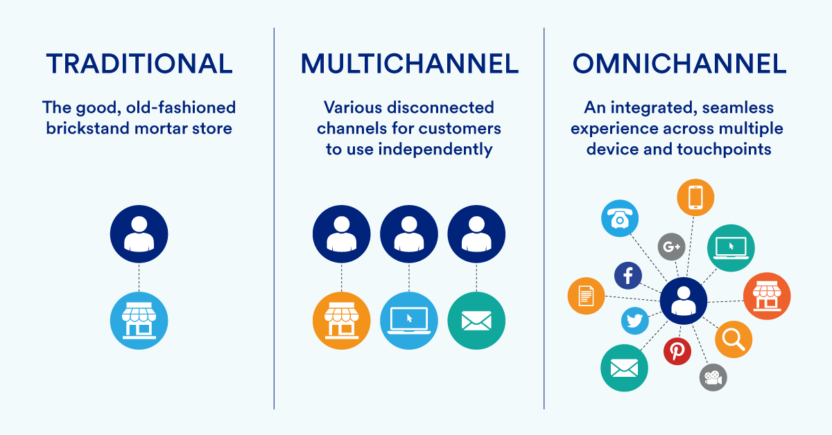
Creating a Perfect Omnichannel Experience
To create a perfect omnichannel experience, understand your customers deeply (probably more than their best friend). Starbucks, for example, understood the customer’s pain point, i.e., their unwillingness to stand in a queue even if they are tempted to grab a cup of coffee, and used it to create an effective omnichannel experience. Closely observe the kind of platforms your customers frequently use to shop, their purchasing behavior, the challenges they face while shopping, how they interact with the brand across each touchpoint, and the devices they use to shop. This data will help you identify the right touchpoints and focus on strengthening them and connecting them to make it a seamless and tailor-made experience for your customers. It will also help you identify customers’ common issues and create a viable solution for them.
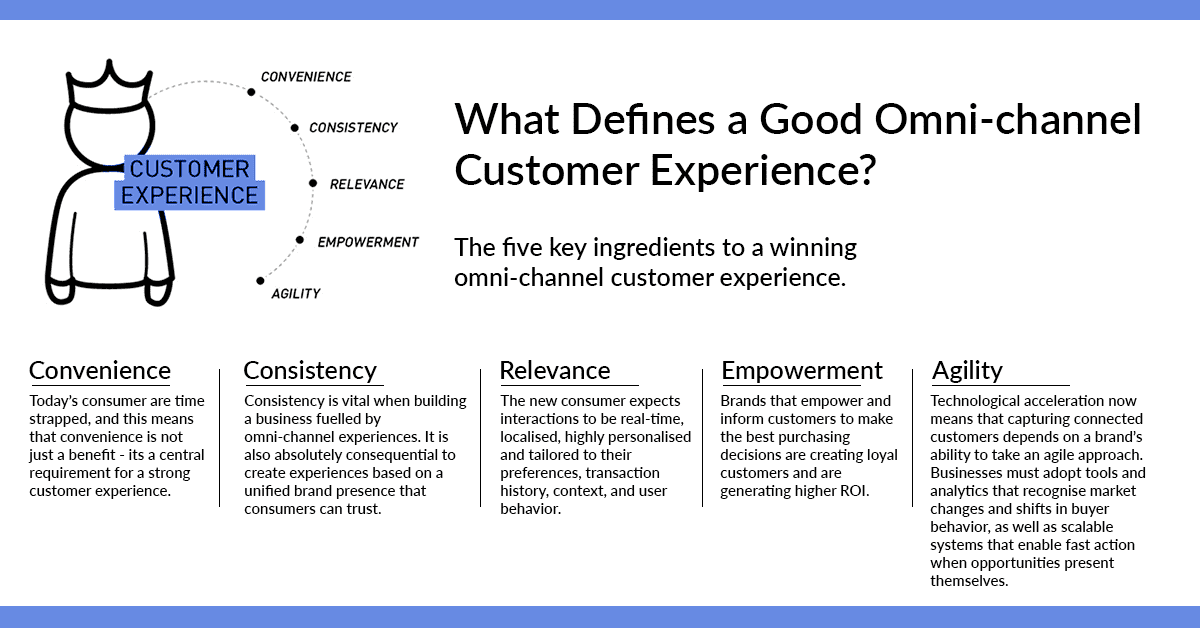
Understanding the Omnichannel Customer Journey Map
A. Elements of an omnichannel customer journey
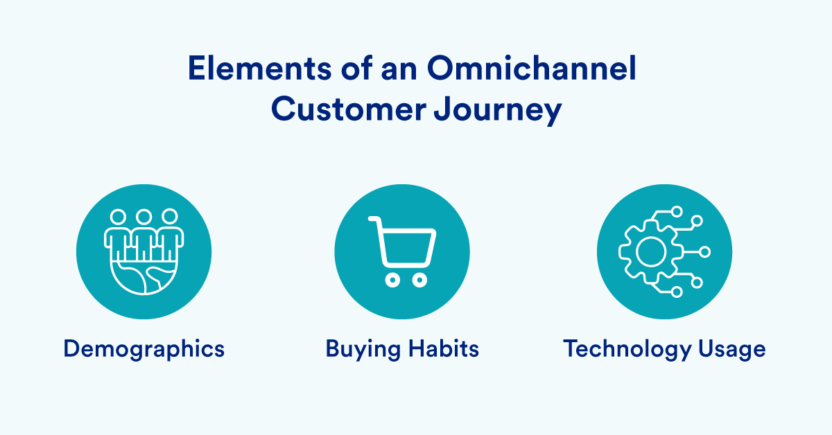
| Demographics | Buying Habits | Technology Usage |
| When building an omnichannel customer journey, you need first to understand who your customers are. Knowing their age, gender, income level, educational background, ethnicity, geographic location, etc. will help you better understand their interests and motivations, enabling you to send personalized messaging. | After examining your audience’s demographics, it’s helpful to understand their buying habits. For this, you can look at their recency (the time since they last engaged with your products), frequency (how many transactions they have had), and monetary (total transaction value) traits. You can also look at what time/days and channels they are most active on. Such actionable insights will help guide your omnichannel approach. | Another key factor to consider when implementing multichannel marketing is what sort of devices, platforms, and channels your customers prefer and how tech-savvy they are. Do they prefer laptops/desktops or mobile devices? Do they use Android or iOS? Do they prefer emails or in-app push notifications? Based on such insights, you can create customer segments and tailor your messaging to push them down the marketing funnel. |
Successful omnichannel marketing requires a deep understanding of your customers, their behaviors, and preferences to deliver relevant experiences that build lasting relationships.
– Seth Godin
B. Stages of the omnichannel customer journey map
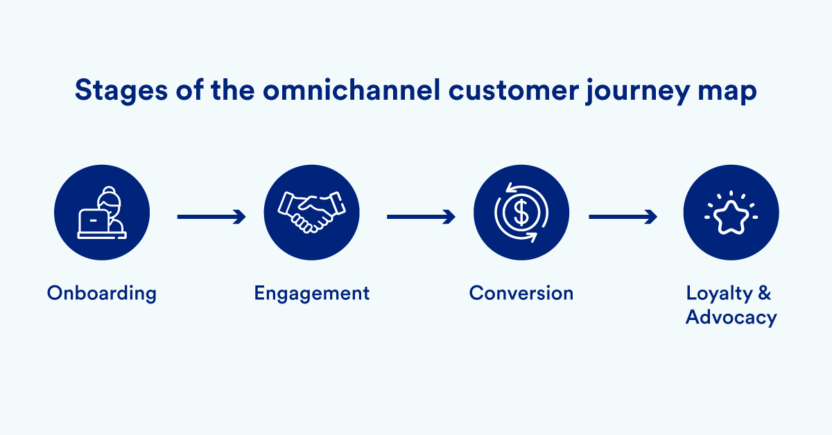
Onboarding: Onboarding is the first step in building a long-lasting relationship with your customer. The good news is that a potential customer downloaded your app or visited your website because they found it relevant. But the onus lies in guiding them through the following steps, creating “aha moments” right in the beginning, enabling easy product adoption, and keeping them engaged enough to eventually convert into your customers. For this, you can send them welcome emails synced to push notifications featuring a new-customer discount, for example. Then you can leverage other channels and send them personalized messaging based on their actions.
Engagement: Keeping a customer engaged on your platform before their first purchase can be quite a challenge. From detecting and reaching out to a potential customer via SMS and push notifications, to sending them emails and WhatsApp messages, you can create customized omnichannel workflows to engage them in a meaningful, personalized manner, on the online channels that resonate with them the most. For instance, using personalized and relevant content that resonate with each customer can be one of the ways to higher conversions and customer satisfaction. This is what worked for Cake Defi, a cryptocurrency platform.
Conversion: This is when you turn a new visitor into a paying customer/subscriber. Sending offers, providing risk-free trial periods, demonstrating your USP, and retargeting are key. You must also leverage social listening and customer feedback to address potential customers’ hesitations. By allowing these hesitations to inform your personalized messaging, you can instill in them the confidence to make the purchase.
Loyalty and Advocacy: With so many brands vying for your customers’ attention, there are high chances that they eventually uninstall your app. But you have to find ways to retain them. In fact, you must take your customers further down the marketing funnel to ensure they become loyal to your brand and your brand advocates. This can help accelerate your acquisition efforts via positive word-of-mouth. You need to provide them with a great omnichannel experience consistently. Exclusive loyalty programs, personalized recommendations, seamless cross-channel experience and support, and consistent messaging all build loyalty and advocacy. By implementing these strategies, brands can enhance the omnichannel experience, retain customers, and turn them into loyal brand advocates, ultimately driving positive word-of-mouth and acquisition efforts.
C. Importance of personalization in the omnichannel customer journey
Consumers are increasingly seeking personalized, omnichannel experiences beyond the price tag. They don’t want to be bombarded with irrelevant or generic messages. Instead, they want customized and timely brand communication catered to their interests and needs. Thus, building 360⁰ customer profiles, gathering actionable insights to understand your customers better, and tailoring all the touchpoints in their omnichannel customer journey is important for building a fantastic buying experience.
In an omnichannel world, brands must prioritize creating a consistent and personalized experience that exceeds customer expectations at every touchpoint.
– Sheryl Sandberg
Here’s what you can do to create a more personalized experience for your customer.
- Personalized Product Recommendations: Use data analytics to recommend products or services based on a customer’s past purchases or browsing behavior. For instance, if a customer frequently searches for budget-friendly travel destinations on your website, your email campaigns can feature relevant travel deals or discounts.
- Behavioral Triggers: Implement triggers that respond to specific customer actions. If a customer abandons items in their online shopping cart, send them a reminder email with those items and possibly a limited-time discount to encourage purchase completion.
- Location-Based Offers: Utilize location data to send customers offers or promotions when they are near one of your physical stores. For instance, a retail brand can send a mobile notification with a special discount when a customer is in proximity to one of their stores.
- Personalized Content: Tailor the content of your communications to match customer preferences. For example, a streaming service can recommend movies or shows based on a user’s genre preferences and viewing history.
Feedback Surveys: Gather feedback through various channels (email, SMS, in-app) and use it to improve the customer experience. Respond to feedback promptly to show customers that you value their input.
How to Build a Perfect Omnichannel Marketing Strategy?
Let’s look at how Disney created a perfect omnichannel marketing strategy to improve people’s experience at their theme parks. Through their website, mobile apps, and Magicbands and cards, Disney has made it easier for visitors to book their stay, check ride timings, book tickets, etc., without standing in a long queue. To create an omnichannel experience like that, you must have a perfect omnichannel marketing strategy.
Here’s what you can do:
- Plan the experience of the customer – Understand their channels, their behavior across all channels, and create a detailed plan on how you want the experience to flow across all the touchpoints.
- Use data as a base while strategizing – With the help of CRM data, social listening data, and customers’ online search behavior, you will know how your customer behaves and can create a solution to address their challenges accordingly. You can even reduce churn by using the data in the right way.
- Segment the customers and personalize the journey – Once you analyze the data, you can easily segment customers into different categories based on common behavior patterns. This will help you identify churning customers, high-risk customers, high-value customers, dormant customers and more, based on which you can create individual personalized journeys.
- Get the context right – The most crucial part of an omnichannel marketing strategy is the context. Sending the wrong message to the wrong audience at the wrong time will dissuade your customers from engaging with you. Ensure that the context of your message is relevant to the customer and send it to the customer when they are most active, and on the channel they engage with the most.
- Select the right marketing automation tools – Use the right omnichannel marketing tools to implement your strategy right from conceptualization to implementation. Do a thorough analysis before selecting the right one. Examine product abilities such as strength, flexibility, robustness, core and extended functions; and understand if the platform is future-ready, scalable and can embrace change.
- Make your organization customer-centric – This is an important step. Unless your employees are not trained to offer a better customer experience, no amount of strategy or marketing tool will help.
Now that you know what omnichannel marketing is and how to create a perfect strategy. Let’s dig deeper to know how to implement it in your organization.
Omnichannel vs. Multichannel vs. Cross-Channel Marketing
Marketers often use terms such as omnichannel, multichannel, and cross-channel interchangeably. After all, they seem to mean the same thing – using multiple channels to acquire, engage and retain your customers. Well, while the essence of all three is the same, a thin line differentiates them. In multichannel marketing, all the communication channels work in isolation with no connection between any of them, whereas, in cross-channel marketing, there are very selected communication channels that are connected.
Omnichannel marketing is much more mature as all the channels work cohesively and in harmony with each other. But how do you determine which one of them is perfect for you? Let’s look at the pros and cons to get a clear picture.
Read – INFOGRAPHIC: 6 Differences between Multi-Channel, Cross Channel and Omnichannel Marketing
Pros and Cons of Multichannel vs. Omnichannel Marketing
The advantage of multi-channel marketing is that it helps you grow your reach using multiple channels. However, due to the lack of cohesiveness, there is no transparency between the channels, and they compete with each other instead of working together. This leads to inconsistent customer experience.
Omnichannel marketing, on the other hand, ensures that the customer experience remains consistent across all channels by tying all the touch-points together and ensuring transparency across all of them. To help you choose between omnichannel vs. multi-channel or cross-channel marketing, we have put together an infographic about the difference between multi-channel, omnichannel and cross-channel marketing that will help you determine the right strategy.
How to Boost Your ROI With Omnichannel Marketing?
To create a best-in-class customer experience, you must show your management how to boost the company’s ROI using omnichannel marketing. To help you do that, we have curated four ways in which you can boost ROI and build a positive experience for your customers:
- Persoanlized messaging: From training your marketing, sales, and customer support staff to personalizing the content at every stage of the customer lifecycle, ensure that the messaging is consistent.
- Consistent experience: To improve the customer lifetime value (LTV), you must deliver a consistent experience across different touchpoints. Ensure that your staff is well-trained to provide such an experience because different customers will interact in different ways with your brand, and there is no one way to do it.
- Continuity in communication: Ensure continuity in communication across all the channels so people are guided throughout the buyer’s journey. To do this, create channel-specific campaign workflows where if you send the first message via SMS, then the second one can be email and WhatsApp (so on and so forth).
- Data-driven marketing: Personalization is the key to successful marketing. Use data-driven marketing to understand your customers, so you can engage with them in the right way by using the right channels.
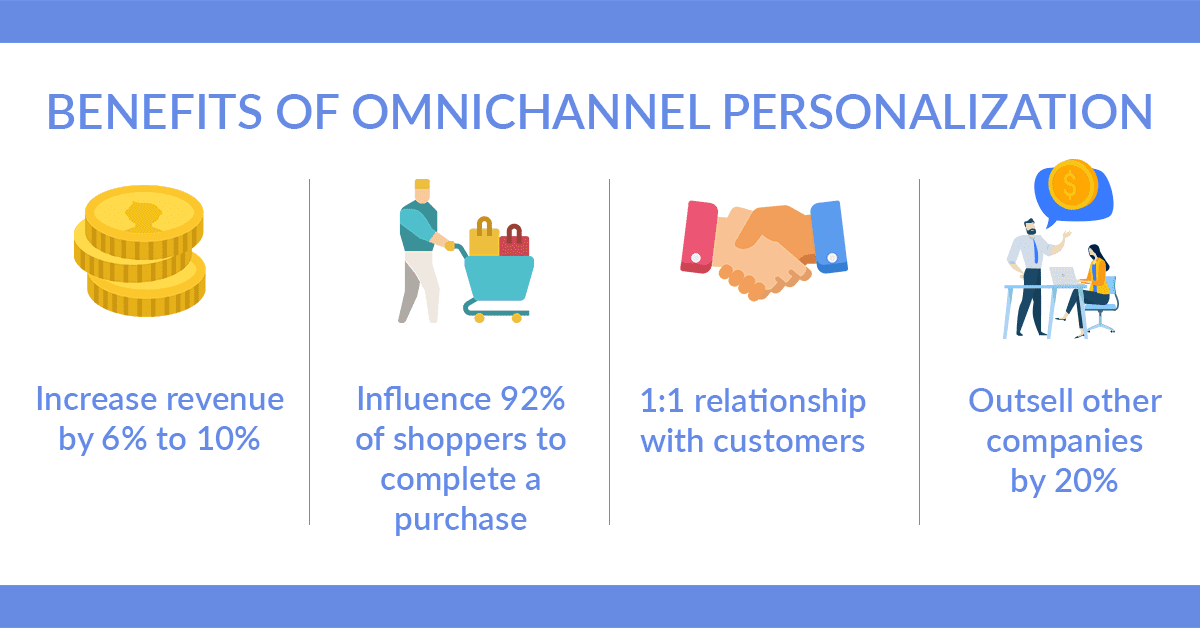
Steps to Measure Omnichannel Customer Engagement ROI
Step 1: Plan Metrics
Create a multichannel marketing plan that includes:
- Channels used in each campaign — sponsored ads, display ads (brand and mobile), social, email, and other channels.
- Opportunity — opens, visits, shares, impressions, and searches.
- Action — click, form fill, click-through, conversion, and co-brand site share.
- Engagement — video view, like-pin-favorite, share, comment, CGI, or game interaction
- Weight — you can add weight depending on your campaign requirement and goal
- Perception — survey answers, brand search terms, and social sentiments
Using these elements and customer data, map your key metrics by channel, action, opportunity, and other required elements. Your channels and metric weight may change based on your campaign goals and multichannel approach.
3 Primary Dashboards
| Parameters | Week-on-Week / Month-on-Month Data | Inclusions |
| Aquisition | Channels are driving traffic — percentage split |
|
| Engagement | Engagement metrics |
|
| Conversion | Conversion funnels |
|
Step 2: Measure Success Metrics
Understand the effectiveness of each channel by determining compound success value based on your key metrics (action, engagement, and perception). The basic formula to determine the success ratio of your omnichannel digital marketing strategy, is:

Step 3: Calculate ROI
Now, include the cost and benefit incurred into your compound success metric to calculate the business impact.
To calculate the closing ROI of the campaign, consider the all-in value determined from the three metric sources:
- Perception = Awareness (impressions, likes, and deliverability rates)
- Engagement = Consideration (opens, clicks, and session length)
- Action = Overall Campaign Goals (customer onboarding, engagement, conversion and/or loyalty)
- Step 4: Learn, Improve, and Repeat
Your work doesn’t end here. The best way to learn is to return to this measurement process continually. These actionable insights allow you to optimize campaigns to attract new customers and increase sales.
How to Use Omnichannel Marketing for Mobile Apps?
Whether it is ordering food, hailing a cab, or making quick payments, smartphones have simplified the lives of people. That’s why it does not come as a surprise when Lisa Gevelber, Google’s VP of Marketing, said that 96% of the users reach out to their smartphone to find answers and 70% of the smartphone users turn to their device before making an in-store purchase. If you have not paid attention to mobile apps, you are probably losing out on many potential customers. A mobile app plays a pivotal role in your omnichannel marketing strategy. However, with an average of 30 mobile apps downloaded on your customer’s smartphone, grabbing their attention can be quite challenging.
73% |
80% |
87% |
67% |
| consumers are more likely to purchase if they have an omnichannel experience. (Harvard Business Review) | customers are more likely to purchase when brands offer personalized experiences across channels. (Epsilon) | customers think brands need to put more effort into providing seamless omnichannel experiences. (Zendesk) | customers shop on one device and continue on another, highlighting the importance of seamless cross-device experiences. (Google) |
There are four ways in which you can center your omnichannel marketing around mobile apps for different customer phases:
- Welcoming new customers: Create a well-planned onboarding strategy to walk the customer through different features of the app.
- Keeping them engaged: Keep your customers engaged on your app, so they don’t uninstall it.
- Re-engaging inactive customers: Use personalized and rich push notifications to re-engage dormant users.
- Convert into brand advocates: Word-of-mouth marketing is the most trusted form of marketing. Use omnichannel marketing to convert your customers into brand advocates.
Here’s an example of Pete using a banking app.
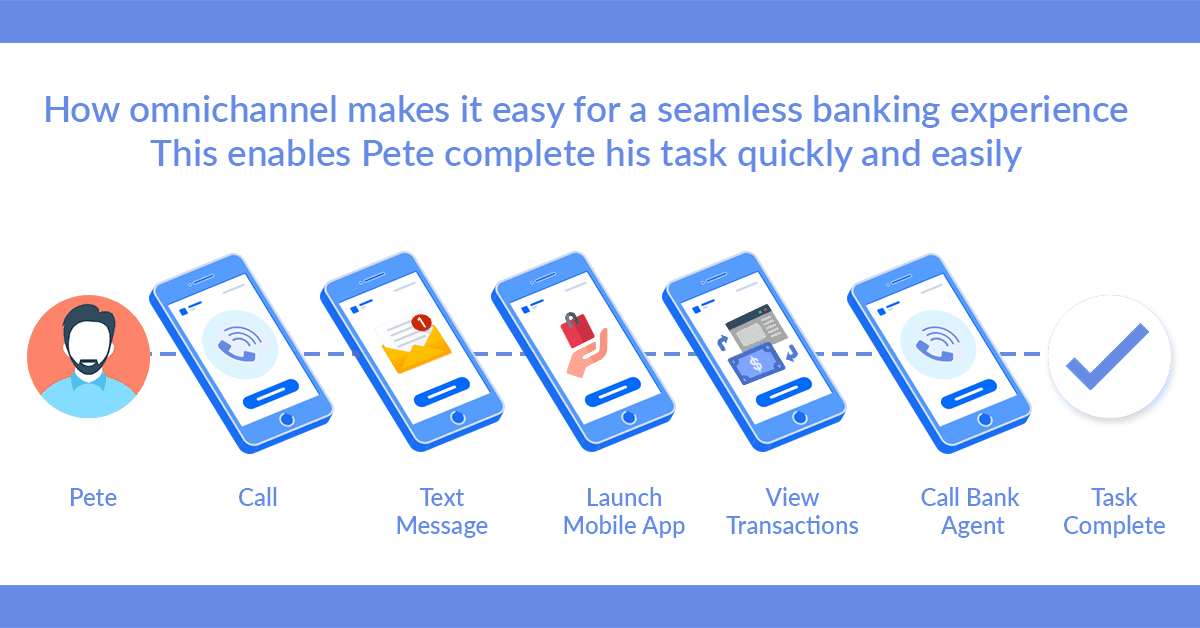
Lessons from 7 Brands That Have Mastered Omnichannel Marketing
What differentiates an excellent omnichannel marketing campaign from a bad one is the consistency in branding and customer experience. You may have the best automation tools and the channels at your disposal to help you implement omnichannel marketing, but it can fail if your strategy is not right. Your customers will not think twice before switching to your competitor if they are offered an inconsistent experience. There is no one-size-fits-all approach to omnichannel marketing strategy. However, if you are looking for some inspiration, head to our blog below where we have curated the stories of seven brands that have planned and deployed successful omnichannel marketing strategies.
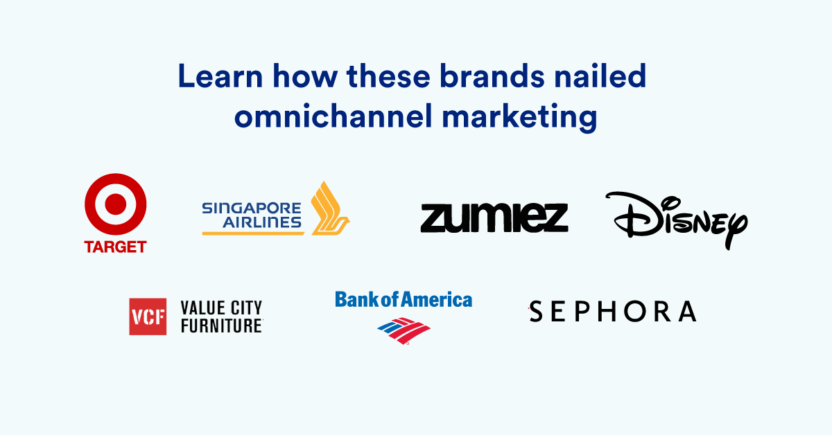
From the omnichannel experience offered by Singapore Airlines to enable customers to shop, pre-book, or earn loyalty in real-time, to the seamless banking experience provided by Bank of America to customers in their branch; you will find some interesting takeaways that can help you build a successful omnichannel marketing strategy.
If interested further, check out other brilliant omnichannel examples worth emulating.
A Beginner’s Guide to Omnichannel Marketing using Marketing Automation
By now, you may have already got some clarity on what omnichannel marketing means and how you can use it to enhance your customer’s experience. You may have also planned your omnichannel strategy. Now, the next step is to deploy the strategy effectively. To do that, you need an omnichannel marketing platform that will help you to offer a seamless experience to your customers across different channels and at various stages of the omnichannel customer journey.
Marketing automation tool also allows you to segment your target audience smartly to personalize the communication and save time on manual tasks. If you are wondering how to use marketing automation tools to personalize the customer journey, look no further.
We have put together a beginner’s guide to omnichannel marketing that explains how you can leverage marketing automation for different customer phases such as onboarding, omnichannel customer engagement, conversions, and retention and win over your customers. What’s more? We have included real-life examples to help you execute a successful omnichannel marketing campaign.
Industry Use Cases of Omnichannel Marketing
You can use omnichannel marketing across several industries, such as:
- Telecom: Omnichannel marketing can be used in the telecom industry to enable customers to pay bills, recharge, or receive notifications about new launches. MoEngage, for instance, helped a telecom company to implement an omnichannel self-serve app to drive engagement and boost revenue. The self-care app improved the revenue for the company by 20%.
- Travel: From reminding the passengers about the upcoming flight a few days before the journey to sending the best deals on hotels and restaurants, the travel industry can capitalize on omnichannel marketing throughout the customer journey.
- Banking: Banks can use omnichannel marketing to remind their customers about the impending bills to be paid, or give the latest credit, debit balance on transactions. You can also announce the launch of new products and reduce the time taken to place a new request or open a new account using omnichannel marketing. A southern European bank, for instance, ensured that there was no interruption in the purchase of credit cards by offering the customer a seamless experience across different devices and channels. The customer could complete the request in 3 minutes instead of 25 minutes.
- Healthcare: Healthcare, being a highly regulated industry, maybe slow at adopting omnichannel technology; however, several healthcare companies have adopted it to provide a good experience to the patients. You can offer services such as reminding the patients about their doctor’s appointments, giving them access to their reports on their devices, and providing daily health tips to improve engagement.
How to Use Omnichannel Marketing Strategies?
For Your E-commerce Business
While we have looked at a few use cases where omnichannel marketing can be used, e-commerce is one business where omnichannel marketing plays a crucial role.
In its report ‘Global Retail Trends 2019‘, KPMG predicted 2019 to be a transformational year for the retail industry. From hyper-personalization to the rise of voice technology, the retail industry is buzzing with new developments.
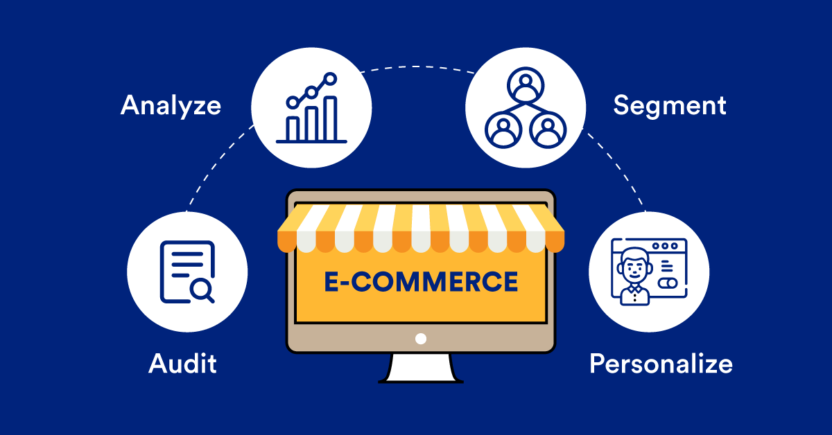
In a hyper-competitive business like e-commerce, your customers are spoiled for choices. You have to cut through the noise to acquire, engage, and retain them on your website. This can be done only through a positive customer experience. You can create a strong relationship with your customers with these seven omnichannel retail strategies:
- Audit your existing marketing strategy, monitor all your channels, and think of ways to improve your existing strategy. Think like a customer when you work on the omnichannel retail marketing strategy.
- Analyze how your customers interact with your brand. Pay close attention to how your customer behaves online and offline and how they make a purchasing decision.
- Segment your audience smartly. The more well-defined your customer segmentation, the more effective it will be your omnichannel marketing strategy.
- Personalize the content for each channel. There are various ways to target your customer – from sending SMSes and emails, to sending push notifications. However, spend time crafting personalized messaging for every channel.
- Do not forget to retarget. Show them relevant banner ads on different platforms such as social media websites; you can create a top-of-the-mind recall, which could increase the chances of conversion.
- Leverage your automation tools as it lets you segment your audience smartly, personalize the messages, schedule your marketing campaigns, and measure its effectiveness quickly. Leverage it to the maximum level possible.
- Test, measure, and repeat using the A/B test and measure the outcome to know what’s working and what’s not.
Read – Driving Repeat Purchases in E-Commerce: 4 Ways to Win
For Your Banking Business
In 2023 and beyond, customers expect banks to continuously provide immediate responses, personalized service across channels, and ease in banking purchases. Customers now have short attention spans and need personalized, seamless experiences. Hence, marketers in banking need to meet customers where they are. Banking services must improve customer relationship management to ensure higher engagement and transactions.
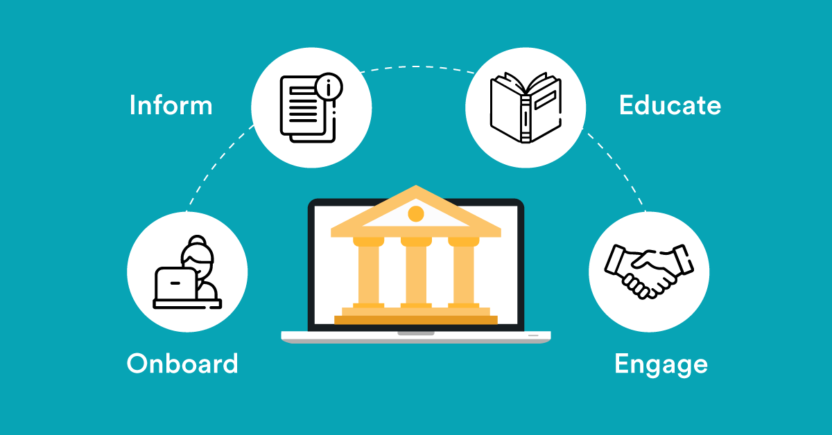
Here are the five strategies to help you create stronger customer interactions and improve customer loyalty.
- Segment your customers using customer data and create user personas across your campaigns.
- Introduce digital banking to personalize banking and financial services powered by mobile apps and web portals.
- Build banking awareness using education programs via emails, newsletters and podcasts that enhance the customer’s financial knowledge.
- Create omnichannel campaigns to engage and reach customers across multiple devices and channels (basically more than one channel).
- Focus on a multichannel approach to build communication across multiple channels, especially online channels.
Omnichannel Marketing Lessons to Learn From Amazon
While discussing omnichannel marketing in the e-commerce industry, let’s look at how Amazon has changed the omnichannel marketing game in the e-commerce space. If you have read Jeffrey and Bryan Eisenberg, and Roy. H. Williams’ book, ‘Be Like Amazon: Even a Lemonade Stand Can Do It,’ you are probably already aware of how Amazon’s customer obsession and culture of innovation has helped them become one of the most influential companies in the world. If you have admired Amazon for its omnichannel e-commerce strategies, you must know about the four crucial omnichannel strategies, which has made them the brand they are today:
- User experience: Amazon always puts their customers at the heart of their business, which enables them to create a best-in-class user experience.
- Customer service: Amazon ensures that it offers the best customer service to its customers. From implementing robots to improve their efficiency to introducing Amazon Prime to offer special benefits to customers, Amazon ensures that their customers are always happy.
- Innovative advertising: Amazon is a pioneer in omnichannel marketing. From SMS, emails, push notifications, and SMSes, they use everything to engage with the customer.
- Diversification in e-commerce marketing: Amazon has ensured it is not restricted to e-commerce alone. It experiments constantly and has also made a strong presence as a brick-and-mortar retail shop.
Read – Top E-commerce Marketing Strategy Fails and How to Avoid Them
How to Fix the Common Mistakes in Omnichannel Marketing?
Despite having the finest marketing automation tools/planning a brilliant marketing strategy, marketers face challenges in creating a seamless omnichannel experience for their customers. Either they are unable to manage the data across various channels or use that intelligently to meet customer expectations. This results in customer churn. Generally, marketers make these seven common mistakes most of the time:
- Ineffective content strategy: Avoid the spray and pray method. Understand your buyer’s persona, how they shop, and create relevant content for every buyer and channel.
- Utilization of data: Data is the new oil. 79% of executives believe that companies will fail without embracing big data solutions. However, unfortunately, marketers have been unsuccessful in utilizing data to its fullest extent. Get a 360-degree view of the data and fix the ones that are not relevant to your business.
- Isolated analytics measurement: As the lines between online and offline channels blur, measuring the success of different touchpoints in isolation will not give you a holistic picture of how your strategy has performed. Consider all the touchpoints as a part of a complete ecosystem and measure them.
- Inaction on new findings: The failure to take actionable steps on the available data can lead to an ineffective marketing campaign. The best way to fix this problem is by hiring technical hires who can optimize the technology and data available about the users and help you to plan a better omnichannel marketing strategy.
- Ineffective strategy: Most customers suffer because of the disjointed experience offered by the brand due to poor strategy. Place the customer at the center of your strategy, and take a data-driven approach to create an effective strategy.
- Failure in implementation: The silos in organizational structure and the proliferation of new channels such as social media and mobile apps can make implementation even more challenging. Shift your focus from channels to customer experiences to fix the problem.
- KPI measurement: While marketers measure the overall effectiveness of the campaign, they fail to measure the KPIs at every stage of the buyer’s journey. Instead of measuring the results for the entire campaign, measure the campaign at every stage of the customer journey.

Source: ClickZ
Omnichannel Marketing Best Practices
Now that you know the mistakes that you need to avoid, let’s look at some of the best practices that you can implement during and after the execution of the omnichannel campaign:
- Understand your buyers and their journey: Customers behave in different ways. Everything differs from their purchasing behavior to how they make decisions. So, take time to understand your buyers, map out their journeys, and work towards creating a strategy accordingly.
- Select the right channels: While some of your channels may be working efficiently, a few may need to improve. You must optimize all relevant channels to deliver a seamless and consistent experience to your customer. There are multiple channels available but only some are relevant to you and your customers. Analyze the ones that your customers frequently use to interact with you and leverage their potential.
- Use the right tools: Several automation tools are available in the market. Study and compare the tools available along the lines of what you want them to do for you, and choose the one that fits your expectations. Refrain from burning your fingers using the wrong tool.
- Help, don’t harass: Your customers would not appreciate your intrusion. So, be wise while sending them messages. Ensure that the message is relevant to the user and sent at a convenient time to them and not you. The right message to the right person at the right time using the right channels – make this your omnichannel marketing mantra.
- Always measure: Always measure the effectiveness of your campaign, so you can identify the strength and the pain points that you need to resolve.
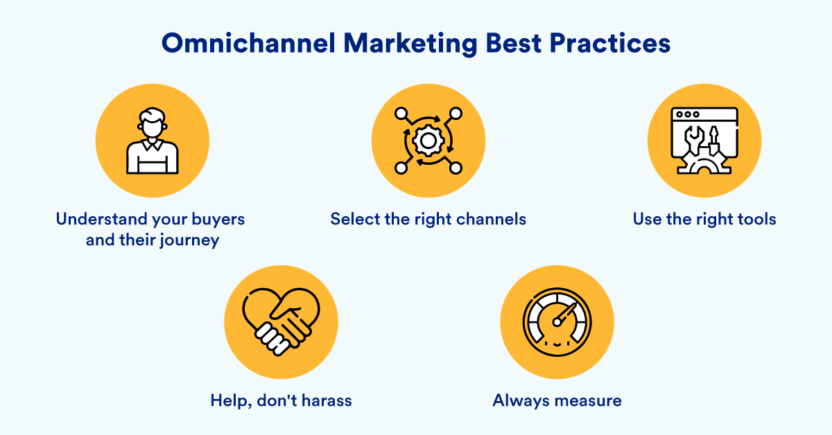
Read – 7 Holiday Marketing Mistakes to Avoid
How to Implement Omnichannel Marketing Across the Customer Journey?
Imagine going to a store and not getting any help from the salespeople. Wouldn’t you just leave the store with a sour experience? Omnichannel marketing without your support is similar to that of a store that does not offer timely assistance. Omnichannel is all about driving customer growth. Omnichannel marketing is not restricted to using the right channels or the right tools alone; you have to be there for your customer at every point of their journey:
Onboarding: Familiarize your customers with your business through onboarding emails and push notifications.
Engagement: Ensure a top-of-the-mind recall by offering them special offers and discounts on your products or by previewing your new launch. If your product is a tool, you can give them a walk-through and offer support whenever needed. You can also send them personalized emails and special discounts during occasions such as their birthday or anniversary. The idea is to ensure that they remember you and feel special to be associated with you.
Brand advocacy: Brand loyalty is rare these days. With so much competition around, gaining your customer’s loyalty should be your priority. Ask for feedback from your customers regularly. However, don’t leave it at that. Thank them for it and if the feedback is worth implementing, do it soon, so they know that you value their opinion and convert into brand advocates.
Driving Growth With Omnichannel Marketing from MoEngage.
Ready-to-Use Omnichannel Marketing Workflows to Grow Conversions
As competition grows, brands must constantly think of new ways to acquire, engage, and retain customers. You need to follow many marketing activities to keep your customers on your platform. But how are you going to do that? How do you ensure your communication is personalized for every customer? How do you make it a well-oiled, self-sustaining activity instead of a one-off activity? The answer to all this lies in using marketing automation workflows.
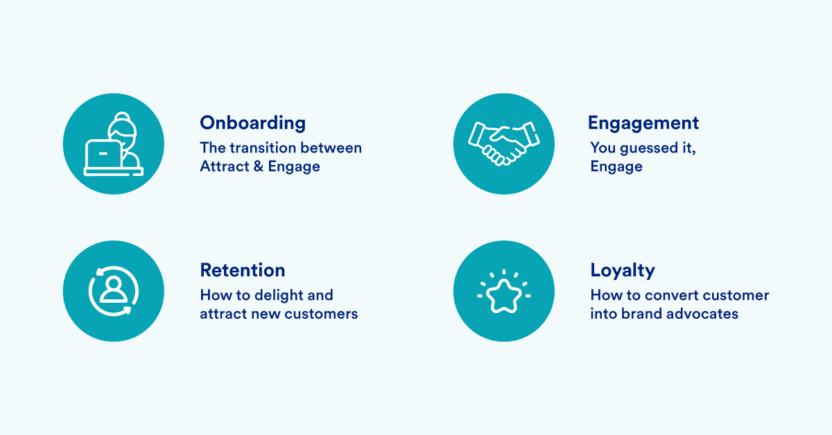
Marketing automation workflows help you to create logical workflows based on pre-defined logic. It helps you to save time and cost on manual activities, minimize customer attrition, and delight customers by offering them a consistent experience across all the channels. To help you grow your business, we have created a guide that will give you ideas on leveraging ready-to-use marketing workflows at every stage of the customer journey. And here’s the bonus – you can also check out some of our ready-to-use omnichannel marketing workflows to get you started.
Omnichannel Marketing Approach for Retailers
The obvious need to know is that every retail brand should adopt or move to a more omnichannel approach. Shoppers worldwide are changing and their buying pattern shifts depending on the device they use to shop. Around 98% of shoppers in the US shift between devices during a purchase. This clearly states that retailers needs start focusing on omnichannel marketing.
It is time retailers unified the shopping experience by allowing shoppers to shop from anywhere, anytime. Especially with around 87% of shoppers expecting retailers to focus on the seamless experience, executing an omnichannel marketing approach is crucial. To help retailers understand the omnichannel concept and its execution, we created a three-part article series that covers:
- Why retailers should opt for an omnichannel approach.
- How retailers can convert their offline shoppers into digital customers using omnichannel marketing.
- What channels to utilize and how to connect them seamlessly.
- What are the benefits of employing omnichannel marketing in a retail world.
- How some top brands are mastering omnichannel campaigns (with examples).
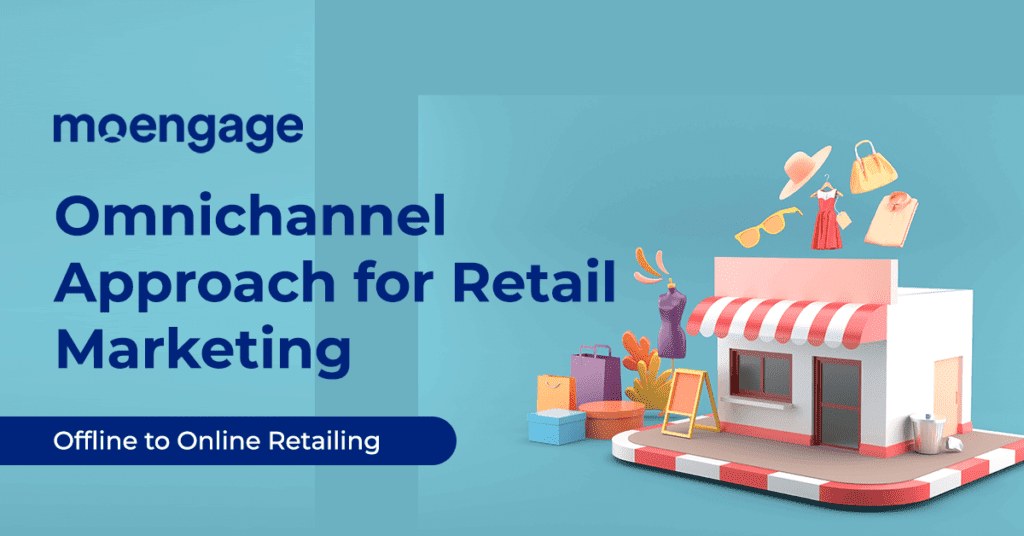
Is Omnichannel Marketing Worth the Effort?
For all the efforts put into understanding the data and creating a seamless experience for the customer across all the channels, it is understandable that marketers might question whether omnichannel marketing is worth it. Here are some prominent statistics, we would like to share to drive home the importance of omnichannel marketing.
- Marketers witness a 250% higher engagement rate with omnichannel channel strategy than single-channel marketing.
- The average order value was 13% more when marketers used the omnichannel strategy.
- Customer retention was 90% more with an omnichannel strategy.
Omnichannel marketing may require your team to combine their marketing and technical expertise and go through a humungous volume of data to create a successful campaign. However, in the end, it will only help you create a positive customer experience. What more do you need than a happy customer willing to return to you repeatedly?
We are committed to helping you create effective omnichannel marketing strategies to enhance your customer experience and grow your business. You can head to our blog to get the latest updates and some inspiration from leading brands and marketing experts on winning the omnichannel marketing game.
Read – Industry Study: eCommerce in Indonesia and How Tokopedia Boosts First-Time Conversions by 20%









